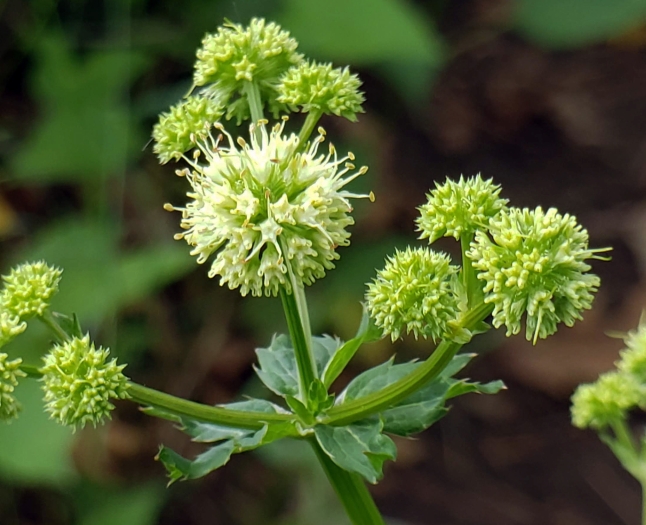Maryland Sanicle
(Sanicula marilandica)
Maryland Sanicle (Sanicula marilandica)
/
/

aarongunnar
CC BY 4.0
Image By:
aarongunnar
Recorded By:
Copyright:
CC BY 4.0
Copyright Notice:
Photo by: aarongunnar | License Type: CC BY 4.0 | License URL: http://creativecommons.org/licenses/by/4.0/ | Rights Holder: aarongunnar | Publisher: iNaturalist | Date Created: 2019-06-05T13:28:10-07:00 |

















































Estimated Native Range
Summary
Sanicula marilandica, commonly known as Maryland sanicle or Maryland black snakeroot, is a perennial herb native to rich, moist deciduous forests and woodland clearings in the Eastern United States and across Canada. It typically grows to a modest height, with the fruiting stalk reaching up to 2 feet, and has a clumping form. The leaves are palmately compound with deeply incised lobes radiating from a central point. In the spring, Maryland sanicle produces small, inconspicuous greenish-yellow flowers that are arranged in umbels. The flowers give way to burr-like fruit in the fall, which are dehiscent and covered in small spines.
Maryland sanicle is valued for its foliage and naturalistic appearance, making it a suitable choice for woodland gardens and native plant landscapes. It is also used in restoration projects due to its adaptability to various woodland conditions. This plant prefers dappled sunlight to part shade and thrives in moist, well-drained soils rich in organic matter. It is relatively low-maintenance once established but may require additional watering during dry periods. While not commonly afflicted by diseases, it can be susceptible to leaf spot. Maryland sanicle is not known for aggressive roots or significant pest problems. It is not typically invasive when grown outside its native range, but gardeners should always monitor and manage their plantings to prevent unwanted spread.CC BY-SA 4.0
Maryland sanicle is valued for its foliage and naturalistic appearance, making it a suitable choice for woodland gardens and native plant landscapes. It is also used in restoration projects due to its adaptability to various woodland conditions. This plant prefers dappled sunlight to part shade and thrives in moist, well-drained soils rich in organic matter. It is relatively low-maintenance once established but may require additional watering during dry periods. While not commonly afflicted by diseases, it can be susceptible to leaf spot. Maryland sanicle is not known for aggressive roots or significant pest problems. It is not typically invasive when grown outside its native range, but gardeners should always monitor and manage their plantings to prevent unwanted spread.CC BY-SA 4.0
Plant Description
- Plant Type: Herb
- Height: 2-3.5 feet
- Width: 1.5-3 feet
- Growth Rate: Moderate
- Flower Color: Green, White
- Flowering Season: Summer
- Leaf Retention: Deciduous
Growth Requirements
- Sun: Full Sun, Part Shade
- Water: Medium, High
- Drainage: Medium
Common Uses
Bee Garden, Butterfly Garden, Low Maintenance
Natural Habitat
native to rich, moist deciduous forests and woodland clearings in the Eastern United States and across Canada
Other Names
Common Names: Black Snakeroot, Maryland Black-Snakeroot, Sanicle Du Maryland, Black Sanicle
Scientific Names: , Sanicula marilandica, Sanicula marilandica var. borealis, Sanicula marilandica var. petiolulata, Caucalis marilandica, Sanicula canadensis var. marilandica, Sanicula marilandica var. marilandica, Triclinium marilandica,
GBIF Accepted Name: Sanicula marilandica L.